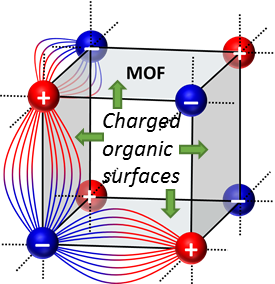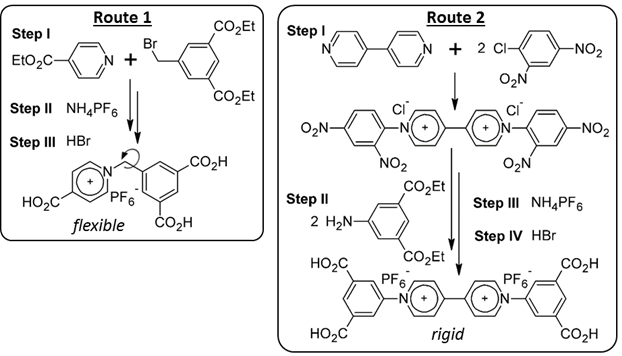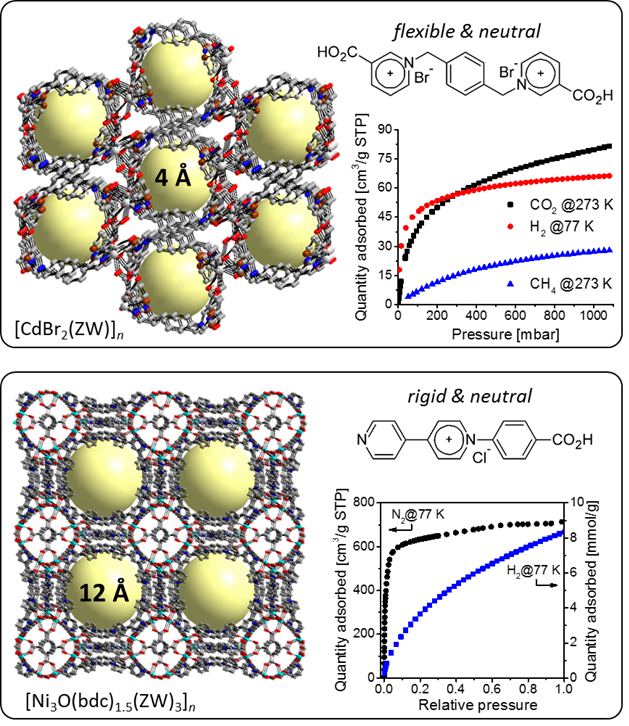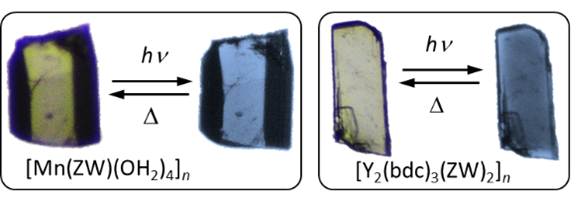Reports: DNI1056295-DNI10: Tunable Host-Guest Interactions in Photo-Functional Metal-Organic Frameworks
Mario Wriedt, PhD, Clarkson University
The crystal structures and physical properties of novel zwitterionic metal-organic frameworks (ZW MOFs) have been systematically explored as a new means to rationally design stimulus-responsive materials for small-molecule separation and storage applications. I proposed that the well-separated intramolecular charges of ZW ligands result in tunable electric field gradients on their molecular surfaces. Most significant advantage: These gradients present potential multi-point adsorption sites that can be designed on a molecular level within the zwitterionic ligand prior to MOF self-assembly. This is an important advantage over conventional MOFs, in which adsorption sites are typically generated through unsaturated metal centers after the MOF is synthesized. I hypothesized that when zwitterions are incorporated into MOFs, these gradients yield Charged Organic Surfaces (COSs) within the pores, which in turn polarize guest molecules, resulting in defined adsorption properties (Fig. 1). Most important feature: Zwitterions are sensitive to light, yielding switchable COSs that enable the controlled release of guest molecules (Fig. 2).
Fig. 1. Schematic representation of COSs in a MOF pore.
Fig. 2. Schematic representation of a ZW MOF pore showing well-separated charges on its surface. These charge gradients yield well-aligned intramolecular electric fields which in turn polarize guest molecules and thus result in multi-point adsorption sites (left). The ZW component can be reversibly reduced to a radical species upon exposure to external stimuli, switching off the COS and releasing adsorbed guest molecules (right).
In initial studies, the synthesis of polytypic (bi) pyridinium-based ZW ligands was optimized for various geometries, flexibilities, charges, and lengths. We demonstrated that these ligands are accessible through nucleophilic substitution reactions of (bi) pyridyls with benzyl bromide- and phenylamine-functionalized carboxylates (Fig. 3). Route 1 is a three-step substitution reaction yielding flexible bipyridinium- and pyridinium-based ZW ligands. Route 2, modified from Zincke reactions, yield rigid bipyridinium- and pyridinium-based ZW ligands respectively in a four-step substitution reaction involving a dinitrobenzene-activated pyridyl unit. Successfully synthesized examples are composed of (iso)nicotinates, pyrdinedicarboxylates and benzyl-/phenyldicarboxylates.
Fig. 3. Nucleophilic substitution of (bi) pyridyls with benzyl bromide- and phenylamine-functionalized carboxylates yields flexible (left) and rigid (right) ligands respectively.
The net charge of ZW ligands was identified as a fundamental structure-directing parameter. Thus, we denote ligands as "neutral" if the number of pyridinium and carboxylate functionalities is equal, whereas in the "anionic" analogs, the number of carboxyls dominates. This classification allows us to specify three general approaches for the systematic design of new ZW MOFs.
(1) The reaction of metal salts with neutral ZW ligands in their non-PF6- exchanged halide-salt forms, which results in compounds with halide anions to counterbalance metal charges. A representative example is shown in Fig. 4.
Fig. 4. Crystal structures and adsorption properties of two new porous ZW MOFs synthesized from neutral ZW ligands. Significant adsorption of various guest molecules can be found, emphasizing the COS accessibility of polarizable guest molecules.
(2) The addition of traditional non-ZW anionic carboxylate-based co-ligands for charge compensation. Since the resulting pores are composed of a binary ligand system, their pore environment could show a partial COS functionality, which implements a further parameter of structural tuning. A representative example is shown Fig. 4, right, using benzene-1,4-dicarboxylate (bdc) as co-ligand. Such systems are of major interest due to their potential for functionalization through isoreticulation. To illustrate, the systematic exchange of co-ligand with 2-aminoterephthalic acid, stilbene-4,4’-dicarboxylate or biphenyl-4,4’-dicarboxylate resulted in an isostructural series of four new ZW MOFs with pore sizes in the range 10–15 Å and surface areas of 2,000–3,000 m2/g.
(3) The reaction of metal salts exclusively with PF6- exchanged anionic ZW ligands. This novel approach leads to ZW MOFs with pore environments showing full COS accessibility. Owing to the non-coordinative nature of PF6-, no charge compensating ions other than the anionic ZW ligands were incorporated into the framework. See representative examples in Fig. 5.
Fig. 5. Crystal structures of two new ZW MOFs synthesized from rigid anionic ZW ligands. Significant solvent accessible voids (>50%) are found and verified by MeOH adsorption experiments (right).
The above breath of new ZW MOFs enabled the systematic investigation of their stimulus-responsive properties. Light-responsive behavior was observed for most materials tested, giving a visible color change upon exposure to UV or sunlight in air within seconds (Fig. 6). This characteristic is similar to that observed for pyridinium radicals, suggesting that the color change arises from the photostimulated generation of free radicals in the pyridinium units. In all cases, the radical generation process was determined to be photoinduced electron transfer from the donor carboxylate anion to the acceptor pyridinium cation within seconds and with stabilities of up to months. This behavior forms the basis of the proposed stimulus-responsive adsorption effect (Fig. 1) and has been experimentally verified as proof-of-concept by a 40% reduction in CO2 adsorption after light exposure (Fig. 7). Most importantly, this effect is reversible (blue data points in CO2 isotherm), as pyridinium radicals are oxidized into their non-radical forms through an oxidative quenching effect upon exposure to air.
Fig. 6. Representative single-crystals of ZW MOFs showing photochromic behavior.
Fig. 8. Crystal structure of a new porous ZW MOF (left) synthesized from a neutral ZW ligand (upper middle). Reversible alteration of CO2 adsorption can be observed upon UV and air exposure respectively (lower middle, blue and black data points overlap), which is accompanied by a significant change in Qst (lower right) and magnetic properties (upper right).
In summary, we showed that extensive accessibility of ZW ligands through established organic synthetic protocols allowed systematic investigations of fundamental structure-property relationships governed by adjustable ligand geometries and tunable intramolecular charge separations. This structural variety will pave the way for analysis of the influence of structural different COSs on the polarization of various guest molecules, such as, but not limited to, CO2, H2 and CH4. This will be subject of future studies to be completed in the second funding period of this grant. Also, we showed that reversible photo-induced radical generation linked with a chromic process of the ZW components provides a unique stimulus-responsive mechanism for the controlled sorption of guest molecules.


















